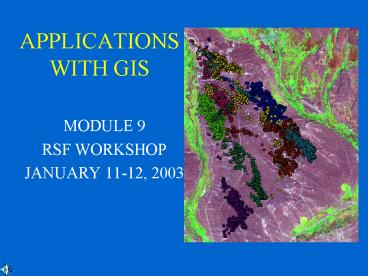APPLICATIONS WITH GIS - PowerPoint PPT Presentation
1 / 30
Title:
APPLICATIONS WITH GIS
Description:
... warbler, savannah sparrow, and alder flycatcher on the Innoko National Wildlife Refuge ... Alder flycatcher results. Model. Standard. Wald. Model. BIC ... – PowerPoint PPT presentation
Number of Views:48
Avg rating:3.0/5.0
Title: APPLICATIONS WITH GIS
1
APPLICATIONS WITH GIS
- MODULE 9
- RSF WORKSHOP
- JANUARY 11-12, 2003
2
RSF and GISAdvantages
- Use of GIS increasing as software is more readily
available and user friendly (e.g., ARCVIEW) - Allows greater flexibility in studying/varying
scale, different definitions of availability - Allows for mapping results, useful management and
research tool - Can investigate many variables
- Do not have to field sample habitat
3
RSF and GISDisadvantages
- Should not be used as a substitute for thinking
- Too many variables, highly correlated
- E.g., 10 variables 210-1 models (no interactions
or quadratic terms considered) - Model selection difficulties
- Derived variables may not relate to selection
- Interpretation
- E.g., what does it mean for moose to be selecting
for an increasing interspersion and juxtaposition
index
4
CASE STUDY
- Moose winter habitat selection
- Data collected by Robert Skinner
- Study area Innoko NWR, AK
- 4 million plus acres
- Innoko river corridor (1994)
- Western strata (1996)
- See Erickson, McDonald, and Skinner (1998)
Resource Selection Using GIS Data A Case
Study, Journal of Agricultural, Biological, and
Environmental Statistic (JABES), v3, p. 296-310
5
Objectives
- Develop a model for winter habitat selection.
- Apply model to the study area for aid in
identifying winter range and strata for other
work (e.g., browse surveys).
6
Field Methods
- Aerial line transect surveys March, 1994 and
1996. - Locations of moose groups fixed using GPS
interfaced with a laptop computer.
7
COVARIATESMoose Habitat Selection, Innoko NWR
- Landcover map (30 m X 30 m resolution) developed
via Landsat TM and standard classification
methods.
8
Innoko River Vegetation Map
9
Buffers
- Data generated
- Proportion of each vegetation type within buffer
- Quadratic effects considered
10
(No Transcript)
11
Why Buffers?Moose Habitat Selection, Innoko NWR
- Buffers around used and available locations
required to calculate pixels in each class - Exact moose locations were not known.
- Can calculate area based metrics
12
Why Buffers?
- Buffers should be generated for both available
and used. - Example
- 25 of each of 4 types at the used location
- Almost always 100 of one type at available
locations - Available locations show less diversity
13
Why Sub-sample Available Locations?
- No need to place available buffers around every
pixel - Can get arbitrarily close to true parameters with
sub-sample. - Sub-sampling reduced data requirements
- A sample of 5170 available buffers was drawn
- 18 million buffers would be required to sample
every pixel
14
(No Transcript)
15
Innoko River Corridor
- Best subsets regression techniques used to choose
the best model (AIC criterion). - BEST MODEL
- w(X)exp((-3.1P3)(4.1P4)(0.5P8)-(8.2P10)-
(8.5P16)-(1.8P18)(6.1P22)-(5.8P42)-
(10.2P222)) - P4Birch/White spruce forest P8Poplar forest
P22Willow, Etc.......
16
(No Transcript)
17
Varying Scale
- Varying buffer sizes changes resolution of
selection - Red patches dominated by willow and birch forest
18
Application
- Modeling and mapping relative probability of use
for blackpoll warbler, savannah sparrow, and
alder flycatcher on the Innoko National Wildlife
Refuge
19
Study Area and Transect Locations
20
FIELD METHODS
- Line transect surveys walked during June
- (3 am-11 am)
- GPS location on transect line and approximate
location of bird
21
GIS DATA LAYERS
- Landsat TM bands 1-5, 7, from August 26, 1991
- elevation (from USGS 163,360 scale quads)
- slope (derived from elevation)
- aspect (derived from elevation)
- distance to river
- distance to lakes
22
(No Transcript)
23
Variables
x
- Experimental unit
- (7 x 7 pixel, or 210 m x 210 m area)
- Means of 49 pixels for each data layer
- Standard deviations of Landsat data (each band)
- Variables calculated for bird locations and
systematic sample of available pixels (i.e,
within floodplain) - Design 1, Sampling Protocol A
24
Statistical Analysis
- Correlation analysis to reduce number of
variables (12) - Logistic regression for estimating coefficients
of RSF model - w(X)exp(b1X1 b2X2... bnXn)
- where Xi is the proportion or a function of the
proportion of a vegetation class - bi estimated from the logistic regression
analyses
25
Model Selection and Reporting
Model importance determined by BIC BIC
-2log(Likelihood) p?log(n)
Model averaging with top five models based on
differences
Model weights
26
Alder flycatcher Empidonax alnorum
27
Alder flycatcher results
Model
Standard
Wald
Model
BIC
Weight
Variable
Estimate
Error
Chi
-
Square
p
-
value
1
911.36
0.376
river
-
0.00077
0.000285
7.3402
0.0067
band 4
0.0412
0.00701
34.54
63
lt.0001
std band 3
0.2278
0.0347
43.1197
lt.0001
std band 4
0.0393
0.0102
14.835
0.0001
elevation
-
0.1191
0.0226
27.8688
lt.0001
28
(No Transcript)
29
Importance Values
30
(No Transcript)































